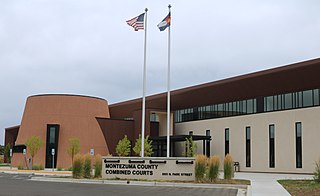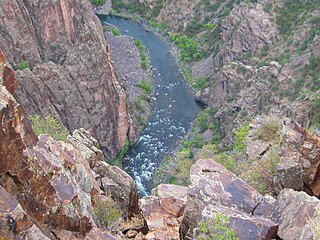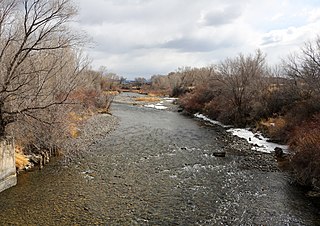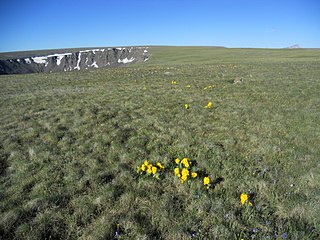
San Miguel County is a county located in the U.S. state of Colorado. As of the 2020 census, the population was 8,072. The county seat is Telluride. The county is named for the San Miguel River.

Montrose County is a county located in the U.S. state of Colorado. As of the 2020 census, the population was 42,679. The county seat is Montrose, for which the county is named.

Montezuma County is a county located in the U.S. state of Colorado. As of the 2020 census, the population was 25,849. The county seat is Cortez.

Mesa County is a county located in the U.S. state of Colorado. As of the 2020 census, the population was 155,703. The county seat and most populous municipality is Grand Junction. The county was named for the many large mesas in the area, including the Grand Mesa, which is the largest flat-topped mountain in the world.

Gunnison County is a county located in the U.S. state of Colorado. As of the 2020 census, the population was 16,918. The county seat is Gunnison. The county was named for John W. Gunnison, a United States Army officer and captain in the Army Topographical Engineers, who surveyed for the transcontinental railroad in 1853.

Dolores County is a county located in the U.S. state of Colorado. As of the 2020 census, the population was 2,326. The county seat is Dove Creek.

The Western Slope is colloquial term generally understood to describe the part of the state of Colorado west of the Continental Divide. Bodies of water west of the Divide flow toward the Pacific Ocean; water that falls and flows east of the Divide heads east toward the Gulf of Mexico. The Western Slope encompasses about 33% of the state, but has just 10% of the state's residents. The eastern part of the state, including the San Luis Valley and the Front Range, is the more populous portion of the state.

The Gunnison River is located in western Colorado, United States and is one of the largest tributaries of the Colorado River.

The Dolores River is a tributary of the Colorado River, approximately 241 miles (388 km) long, in the U.S. states of Colorado and Utah. The river drains a rugged and arid region of the Colorado Plateau west of the San Juan Mountains. Its name derives from the Spanish El Rio de Nuestra Señora de Dolores, River of Our Lady of Sorrows. The river was explored and possibly named by Juan Maria Antonio Rivera during a 1765 expedition from Santa Fe.

The Uncompahgre River is a tributary of the Gunnison River, approximately 75 mi (121 km) long, in southwestern Colorado in the United States. Lake Como at 12,215 ft (3723m) in northern San Juan County, in the Uncompahgre National Forest in the northwestern San Juan Mountains is the headwaters of the river. It flows northwest past Ouray, Ridgway, Montrose, and Olathe and joins the Gunnison at Confluence Park in Delta.

The Powderhorn Wilderness is a 62,050-acre (251.1 km2) wilderness area in Hinsdale and Gunnison counties, Colorado, United States, located 5 miles (8.0 km) northeast of Lake City.

Uncompahgre National Forest is a U.S. National Forest covering 955,229 acres in parts of Montrose, Mesa, San Miguel, Ouray, Gunnison, Hinsdale, San Juan, and Delta Counties in western Colorado. Its headquarters are in Delta County, in the city of Delta. It borders the San Juan National Forest to the south.

Unaweep Canyon is a geologically unique canyon that cuts across the Uncompahgre Plateau, Mesa County, in western Colorado. It is unique because two creeks, East Creek and West Creek, flow out of opposite ends of the canyon, separated by the almost imperceptible Unaweep Divide. State Highway 141 runs inside Unaweep Canyon between Whitewater and Gateway, one segment of the Colorado-designated Unaweep/Tabeguache Scenic Byway. The Unaweep Divide, elevation 7,048 ft (2,148 m), is near mile marker 135 on SH 141.
The San Juan Skyway Scenic and Historic Byway is a 236-mile (380 km) All-American Road, National Forest Scenic Byway, and Colorado Scenic and Historic Byway located in Dolores, La Plata, Montezuma, San Juan, and San Miguel counties, Colorado, USA. The byway forms a loop in southwestern Colorado traversing the heart of the San Juan Mountains. The San Juan Skyway reaches its zenith at Red Mountain Pass at elevation 11,018 feet (3,358 m). Mesa Verde National Park was one of the original UNESCO World Heritage Sites. The Silverton Historic District and the Telluride Historic District are National Historic Landmarks.

The Gunnison National Forest is a U.S. National Forest covering 1,672,136 acres in Mesa, Gunnison, Hinsdale and Saguache Counties in Western part of the U.S. state of Colorado. It borders the White River National Forest to the north, the Grand Mesa and Uncompahgre National Forests to the west, the San Isabel National Forest to the east and the Rio Grande National Forest to south. It lies in parts of five counties. In descending order of land area within the forest they are Gunnison, Saguache, Hinsdale, Delta, and Montrose counties.

The Uncompahgre Valley is an agricultural valley of the Uncompahgre River around the town of Montrose in the western part of the U.S. state of Colorado. The valley is bounded to the south and east by the San Juan Mountains and to the west by the Uncompahgre Plateau. The valley contains about 135,000 acres of irrigable land, is 35 miles long, and approximately 12 miles wide.

Areas of Critical Environmental Concern (ACEC) is a conservation ecology program in the Western United States, managed by the Bureau of Land Management (BLM). The ACEC program was conceived in the 1976 Federal Lands Policy and Management Act (FLPMA), which established the first conservation ecology mandate for the BLM. The FLPMA mandate directs the BLM to protect important riparian corridors, threatened and endangered species habitats, cultural and archeological resources, as well as unique scenic landscapes that the agency assesses as in need of special management attention.
Kannah Creek is a watershed that descends from the top of the Grand Mesa west southwest, where it meets the Gunnison River about 25 miles south of Grand Junction, Colorado. It offers many recreational opportunities, irrigation, and is an important source of drinking water for Grand Junction. The Grand Mesa is one of the largest flat topped mountains in the world and has over 300 lakes and reservoirs on top, many of which are in the Kannah Creek watershed, which help retain much of Grand Junction's drinking water throughout the year as the snowpack melts and converts into runoff. Kannah Creek is also the namesake for the locally popular Kannah Creek Brewing Company. Kannah Creek is an extremely important source of water, originating on an elevated oasis, in an otherwise very arid region.
The Paradox Trail is located in western Montrose County, Colorado and traverses a route of over 118 miles (190 km) through various terrain. The trail was rerouted 17 miles due to a trespass issue near the Tabeguache area north of Nucla in 2017. The trail links with two other long-distance trails in the region, the Tabeguache Trail to the east on the Uncompahgre Plateau and the Kokopelli Trail to the west in the La Sal Mountains of Utah. These three trails together form the "Grand Loop", a grueling 360 mile course.

















